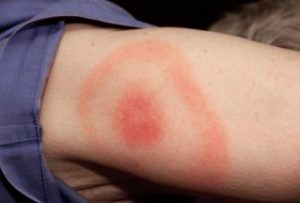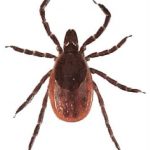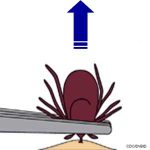Originally published May 2, 2014

Lyme disease is caused by a spirochete: a type of bacterium, Borrelia burgdorferi, which is transmitted to dogs by a tick. The most common type of tick to carry Lyme disease is the Deer Tick. Once in the blood stream, the Lyme disease organism is carried to many parts of the body but tends to localize in the joints.
Lyme disease affects both dogs and people, but people cannot get it directly from a dog. The disease is transmitted by ticks, therefore preventing tick bites is important for your health and that of your dog.
Clinical Signs of Lyme Disease
 Humans with Lyme disease develop a characteristic “bull’s-eye” rash around the bite in three to thirty days. This makes the disease easy to diagnose at an early stage. Lyme disease is more difficult to detect in animals. Dogs and cats do not develop this characteristic rash. Other symptoms may be delayed or go unrecognized because the symptoms are similar to those of many other diseases. Lyme disease in animals is often not even considered until other diseases have been eliminated.
Humans with Lyme disease develop a characteristic “bull’s-eye” rash around the bite in three to thirty days. This makes the disease easy to diagnose at an early stage. Lyme disease is more difficult to detect in animals. Dogs and cats do not develop this characteristic rash. Other symptoms may be delayed or go unrecognized because the symptoms are similar to those of many other diseases. Lyme disease in animals is often not even considered until other diseases have been eliminated.
Many dogs affected with Lyme disease are taken to a veterinarian because they seem to be in pain and have stopped eating. Often these pets have high fevers and may begin limping. This painful lameness often shifts from one leg to another and may even disappear, only to recur weeks or months later.
Diagnosing Lyme Disease
Dogs with fever, lameness, and swollen joints should be suspected of having Lyme disease, although other diseases can cause these symptoms. There are two blood tests used to confirm:
An antibody test does not detect the spirochete in the blood but does detect the presence of antibodies created by the dog’s body if infected by the organism. This test can return a negative reading if the dog is infected but has not yet formed antibodies. Dogs with suppressed immune systems may not form sufficient antibodies to trigger this test. Also, dogs that have been infected for a long time may no longer have enough antibodies present to be detected by the test. Therefore, a positive test is meaningful, but a negative is not conclusive.
A polymerase chain reaction (PCR) test is a DNA test that is very specific and sensitive. However, the dog may not have the spirochete in their blood cells, so a blood sample may yield a false negative. The fluid from an affected joint yields the best sample for PCR testing.
Treating Lyme Disease
Because the Lyme disease spirochete is a bacterium, it can be treated with antibiotics. However, it may require a lengthy course of treatment to eradicate the organism. If the infection is long-standing, treatment may require changing to another antibiotic after the initial course. If not eradicated, the initial infection will recur. The dog can also be re-infected by being bitten by another infected tick once treatment is complete.
Preventing Lyme Disease
 The key to prevention is keeping your dog from being bitten by ticks. There are several effective topical and oral pharmaceuticals which are designed for tick control. A vaccine is available for protecting dogs against Lyme disease and has been shown to be safe and effective. The dog is initially vaccinated twice, at a two to three week interval. Annual re-vaccination is necessary to maintain immunity. Check with your veterinarian for recommendations for your area and pet.
The key to prevention is keeping your dog from being bitten by ticks. There are several effective topical and oral pharmaceuticals which are designed for tick control. A vaccine is available for protecting dogs against Lyme disease and has been shown to be safe and effective. The dog is initially vaccinated twice, at a two to three week interval. Annual re-vaccination is necessary to maintain immunity. Check with your veterinarian for recommendations for your area and pet.
Ticks are found in grassy, brushy or wooded areas. They climb to the top of a leaf, blade of grass, or short tree, especially Cedar trees, and wait for an animal (or person ) on which to crawl or drop. Keeping animals from thick underbrush and tall grass reduces their exposure to ticks. Dogs should be kept on trails when walked near wooded or tall grass areas. After a walk, inspect them (and yourself) carefully for ticks.
) on which to crawl or drop. Keeping animals from thick underbrush and tall grass reduces their exposure to ticks. Dogs should be kept on trails when walked near wooded or tall grass areas. After a walk, inspect them (and yourself) carefully for ticks.
If you find a tick, grasp it firmly with your fingernails or a tweezers at the dog’s skin level and pull firmly, straight up to remove it. It is important to remove ticks quickly.
| If you enjoy our updates, Doggy Tales, and educational articles consider subscribing for notices when new pieces are posted. It’s painless and you can unsubscribe any time you want. Your e-mail address is used ONLY to deliver these notices. | [email-subscribers namefield=”YES” desc=”” group=”Public”] |



